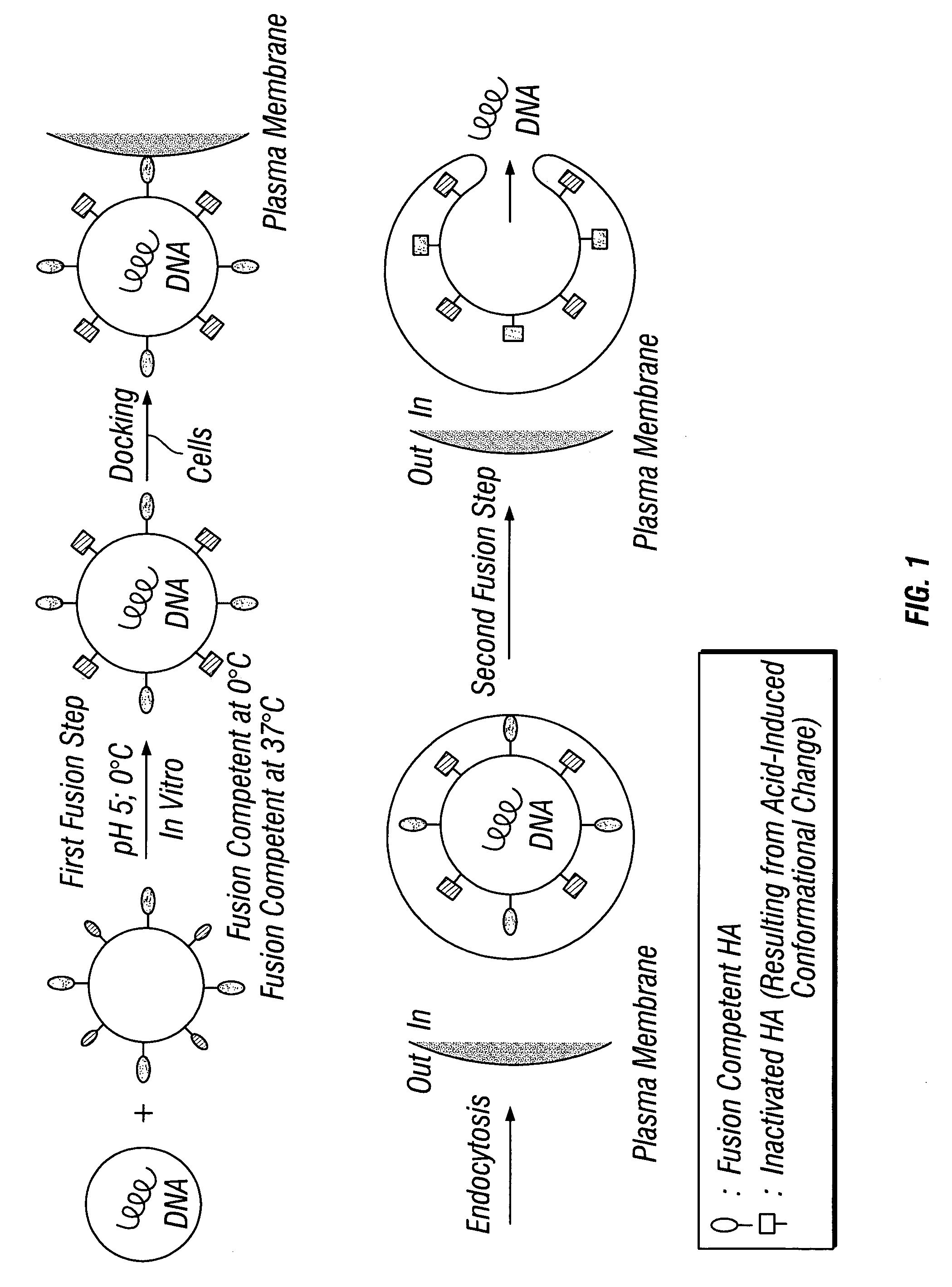High-efficiency fusogenic vesicles, methods of producing them, and pharmaceutical compositions containing them
a fusogenic vesicle, high-efficiency technology, applied in the field of new drugs, can solve the problems of low cell delivery efficiency, limited nucleic acid delivery, and insufficient safety profiles
- Summary
- Abstract
- Description
- Claims
- Application Information
AI Technical Summary
Benefits of technology
Problems solved by technology
Method used
Image
Examples
example 1
[0048]Materials and Methods: Chemicals: Octaethyleneglycol-mono-(n-dodecyl)ether (OEG, C12E8) and didodecyldimethylammonium bromide (DDAB) were from Fluka, poly-L-lysine hydrobromide (MW 29'300), protamine sulfate, -cellulose, microcrystalline cellulose and 1,2-Dipalmitoyl-sn-glycero-3-phospho-rac-(1-glycerol) (PG) were purchased from Sigma (Buchs, Switzerland). Egg phosphatidyl choline (PC) was obtained from Lipoid (Cham, Switzerland).
[0049]Phosphatidylethanolamine (PE) was obtained from R. Berchtold (Biochemical Laboratory, University of Bern, Switzerland). Bio-beads SM2 and Bio-Gel A-15m were from Bio-Rad Laboratories (Glattbrugg, Switzerland). POPC, N-NBD-PE and N-Rh-PE were from Avanti Polar Lipids (Birmingham, Ala., USA). Pancreatic DNase I (from bovine pancreas) with a specific activity of 2000 Kunitz units / mg and exonuclease III (E. coli with 100 units / μl) were purchased from Roche Diagnostics (Basel, Switzerland) and New England BioLabs (BioConcept, Allschwil, Switzerland)....
example 2
[0052]Preparation of immunopotentiating reconstituted influenza virosomes (IRIV): Virosomes were prepared by the method described by Bron and coworkers (Bron et al., Methods Enzymol. 220: 313-331, 1993). Briefly, virus (1.5 μmol of phospholipid or 5 mg of viral protein) was sedimented by ultracentrifugation and solubilized in 0.7 ml of 100 mM OEG in phosphate-buffered saline (PBS, 150 mM NaCl, 5 mM Na-phosphate, pH 7.4). The nucleocapsid was removed by ultracentrifugation (100'000×g, 30 min). The supernatant (containing the viral lipids and the envelope proteins) was shaken (1200 rpm) with 180 mg of wet Bio-Beads SM2 for 1 h at room temperature and twice for 10 min with 90 mg of Bio-Beads at 1400 rpm to remove the detergent.
[0053]Subsequently, the virosome preparation was centrifuged on a 10-40% (w / v) discontinuous sucrose density gradient in PBS at 130'000×g for 90 min. The virosomes were collected from the interface between the sucrose layers.
[0054]Chimeric virosomes containing HA...
example 3
[0056]Preparation of conventional IRIV with encapsulated molecules: IRIV were basically prepared as described by Zurbriggen et al. (Zurbriggen et al., Prog. Lipid Res. 39:3-18, 2000). Briefly, 32 mg egg PC and 8 mg PE were dissolved in 2 ml of PBS containing 100 mM OEG (PBS / OEG). Influenza A / Singapore was purified as described (Skehel and Schild, Virology 44:396-408, 1971). Influenza virus corresponding to 4 mg hemagluttinin (HA) was centrifuged at 100,000×g for 30 min and the pellet was dissolved in 1 ml of PBS / OEG. To prepare peptide-IRIV, 4 mg of peptide was dissolved in 1 ml PBS / OEG. The phospholipids, the dissolved virus solution and the peptide solution were mixed and sonicated for 1 min. This mixture was centrifuged at 100,000×g for 1 h and the supernatant sterile filtered (0.22 μm). Virosomes were then formed by detergent removal using 180 mg of wet SM2 Bio-Beads for 1 h at room temperature with shaking and three times for 30 min with 90 mg of SM2 Bio-Beads. Size determinati...
PUM
| Property | Measurement | Unit |
|---|---|---|
| diameter | aaaaa | aaaaa |
| diameter | aaaaa | aaaaa |
| diameter | aaaaa | aaaaa |
Abstract
Description
Claims
Application Information
 Login to View More
Login to View More - R&D
- Intellectual Property
- Life Sciences
- Materials
- Tech Scout
- Unparalleled Data Quality
- Higher Quality Content
- 60% Fewer Hallucinations
Browse by: Latest US Patents, China's latest patents, Technical Efficacy Thesaurus, Application Domain, Technology Topic, Popular Technical Reports.
© 2025 PatSnap. All rights reserved.Legal|Privacy policy|Modern Slavery Act Transparency Statement|Sitemap|About US| Contact US: help@patsnap.com



